Sandy soil can be a challenge to garden in. Depending on how much sand is in your garden soil, sandy earth can drain too quickly and leave plants parched. Sandy gardens also don’t hold onto nutrients well, and soil can become nutrient deficient quicker than with other soil types.
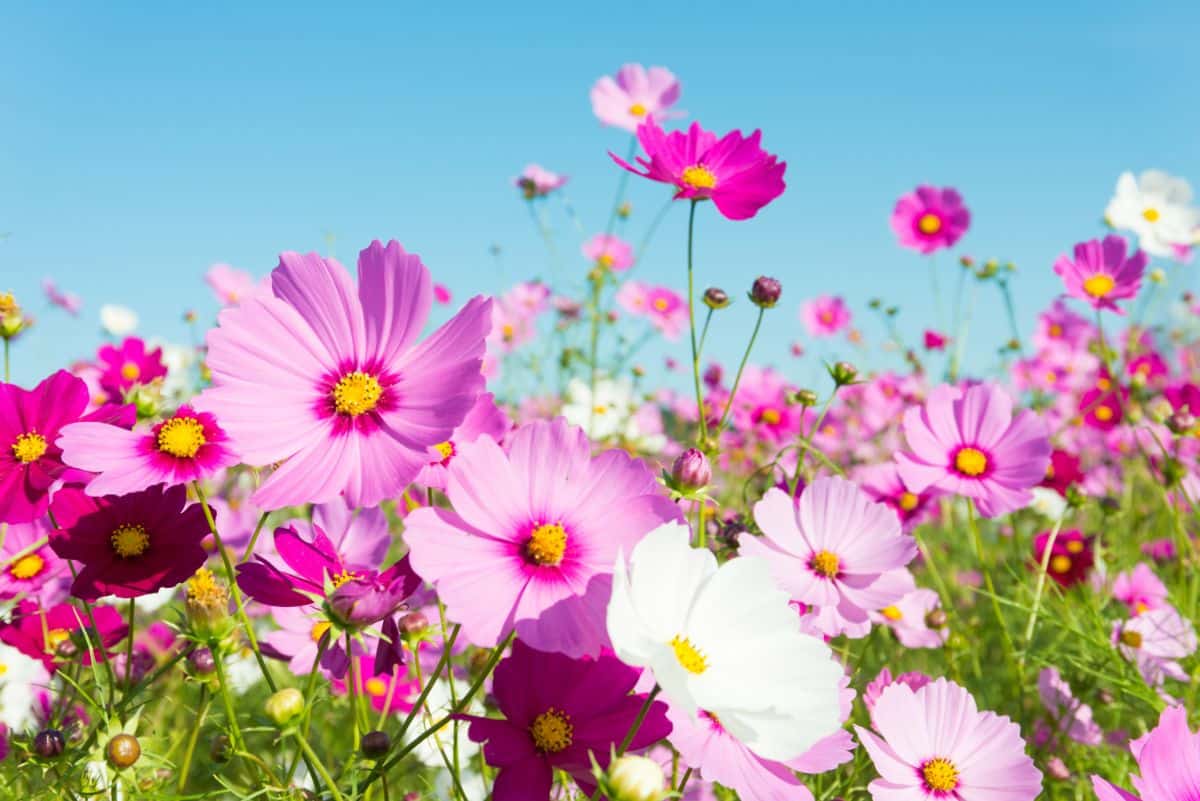
Amending your sandy soil with a bit of compost before planting is a good way to correct this issue. But even after mixing in compost, your soil will still be on the sandy side. Choosing plants that thrive in these growing conditions will make it easier to maintain healthy plants, and it will cut down on your gardening tasks too.
In the list below, you’ll find some of the best flowering plants to grow in sandy earth. Try sowing a few of them together for lots of garden color!
Jump to:
- 21 best flowers to grow in sandy soil
- 1. Lavender (Lavandula spp.)
- 2. Sedum (Sedum spp.)
- 3. Black-eyed Susan (Rudbeckia hirta)
- 4. Sweet alyssum (Lobularia maritima)
- 5. Bearded iris (Iris × germanica)
- 6. Butterfly bush (Buddleja spp.)
- 7. Foxglove (Digitalis spp.)
- 8. Daylily (Hemerocallis lilioasphodelus)
- 9. Giant allium (Allium giganteum)
- 10. Russian sage (Perovskia atriplicifolia)
- 11. Phlox (Phlox paniculata)
- 12. Joe Pye weed (Eutrochium purpureum)
- 13. Salvia (Salvia spp.)
- 14. Butterfly weed (Asclepias tuberosa)
- 15. Liatris (Liatris pycnostachya)
- 16. Cleome (Cleome spp.)
- 17. Columbine (Aquilegia spp.)
- 18. Hosta (Hosta spp.)
- 19. Larkspur (Delphinium spp.)
- 20. Cosmos (Cosmos spp.)
- 21. Yarrow (Achillea millefolium)
- Summary
21 best flowers to grow in sandy soil
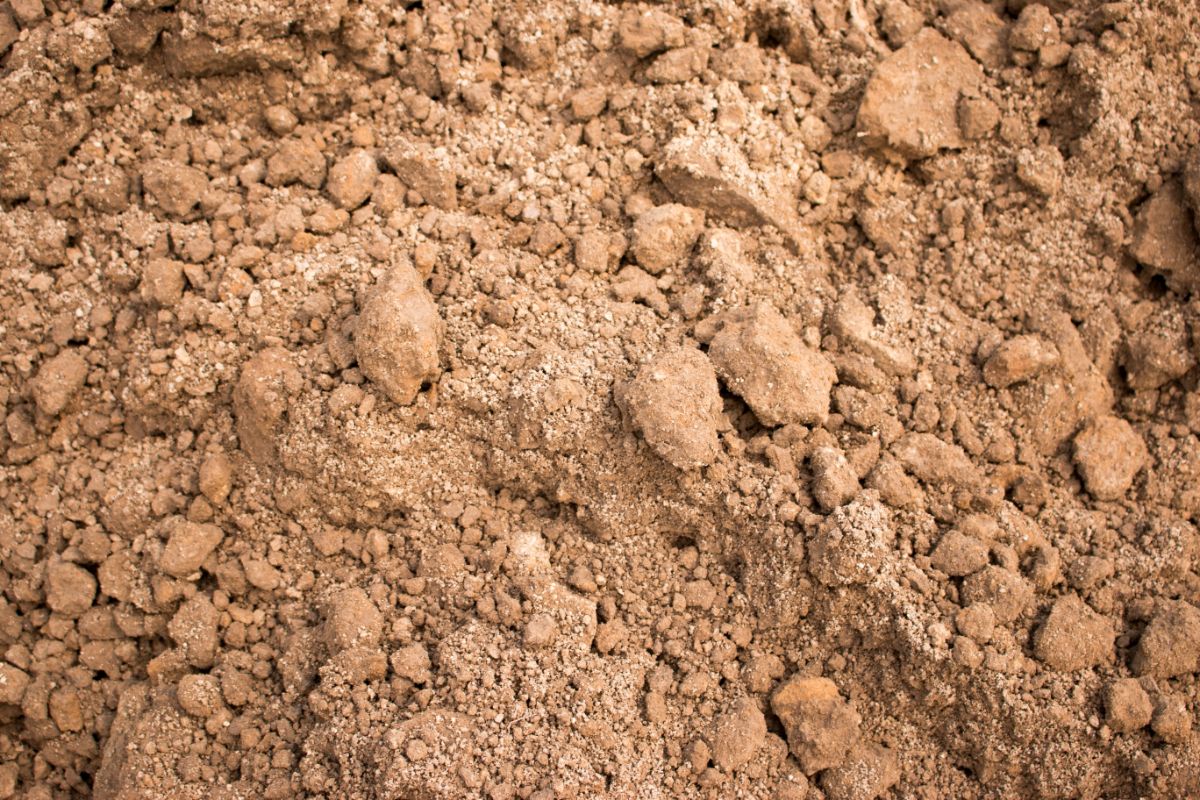
Choosing plants that are well-suited for sandy soil will cut down on your gardening chores and reduce your watering needs too. From flowering herbs to perennial favorites, there are a lot of plants that are well-adapted to sandy gardens.
1. Lavender (Lavandula spp.)
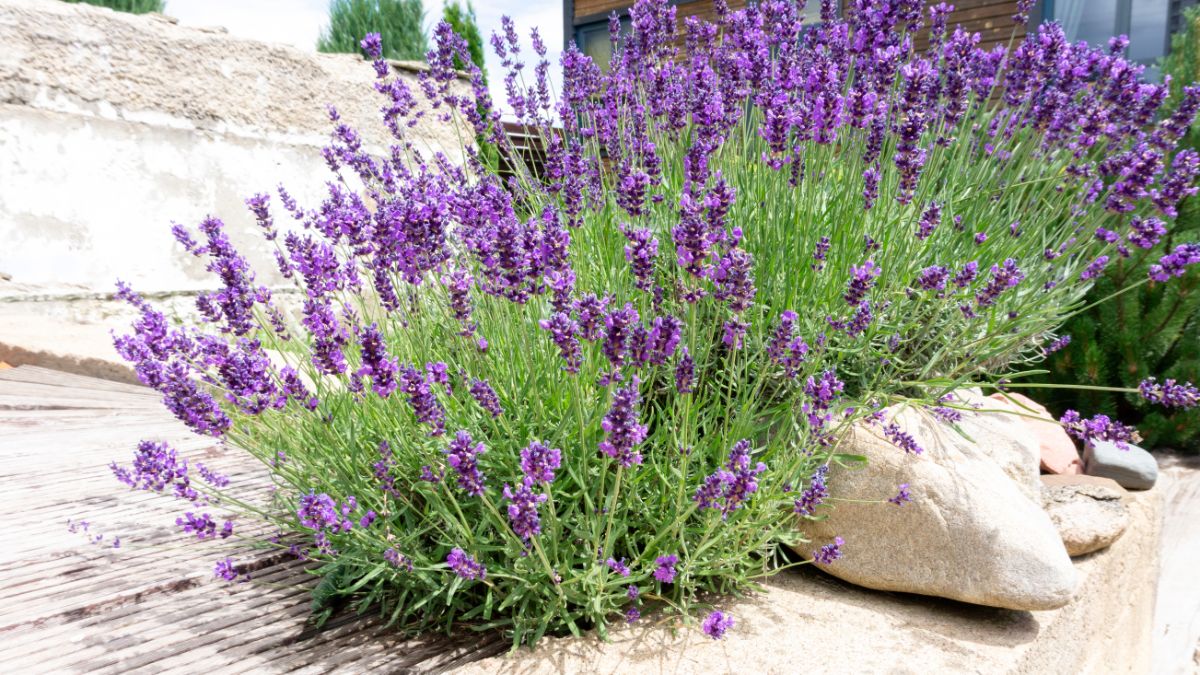
| Plant name: | Lavender |
| Light requirements: | Full sun |
| Water requirements: | Low |
| Growing zone: | Zones 5 to 9 |
| Special features: | Edible; Highly fragranced |
Native to the Mediterranean, lavender naturally grows in well-draining, sandy soils. Sowing lavender in soil that is too rich or waterlogged is one of the main reasons gardeners struggle to keep this plant happy. But if you have sandy soil, you’re already one step ahead when it comes to growing lavender!
There are 47 types of lavender available today, including species with smooth or feathery leaves, different colored blooms, and different growing needs. Some lavender types, like French lavender, grow better in humid locations, while ‘Hidcote’ lavender is well-known for its cold hardiness. Whichever lavender you choose to grow, keep it in bright sun and water sparingly.
2. Sedum (Sedum spp.)
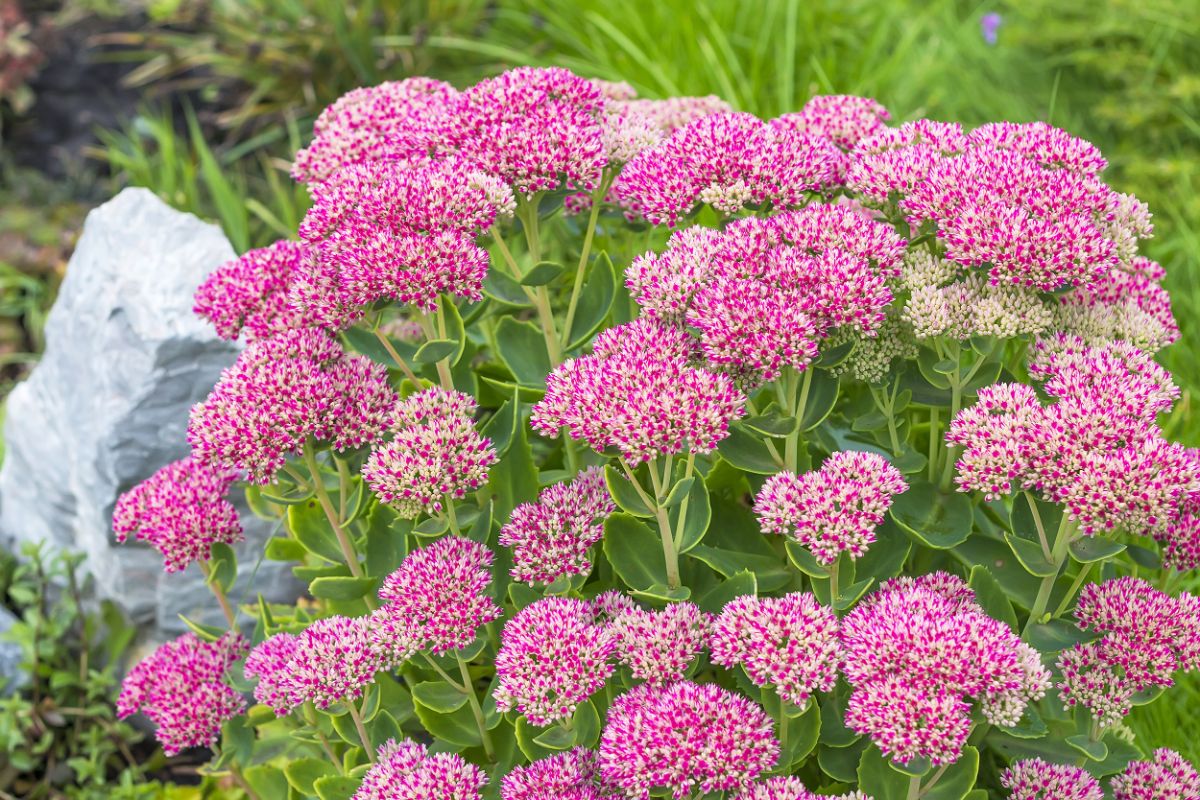
| Plant name: | Sedum |
| Light requirements: | Full sun |
| Water requirements: | Low |
| Growing zone: | Zones 3 to 11 |
| Special features: | Drought tolerant; Late season blooms |
Also known as stonecrop, sedum is a succulent, and it doesn’t need a lot of water. So, if you happen to have sandy soil that drains too fast for other plants, you may want to grow some sedum. These adaptable plants are often featured in rock gardens, and they make stunning border plants too!
With between 400 and 600 different species of sedum to choose from, you can find just the right sedum variety for your garden. Species like ‘Dragon’s Blood’ make exceptional, low-maintenance ground covers, while taller sedum species like ‘Autumn Joy’ are perfect specimen plants. Beyond their beauty, sedum blooms are very attractive to pollinators and provide an important source of nectar and pollen late in the season after most other flowers have faded.
3. Black-eyed Susan (Rudbeckia hirta)
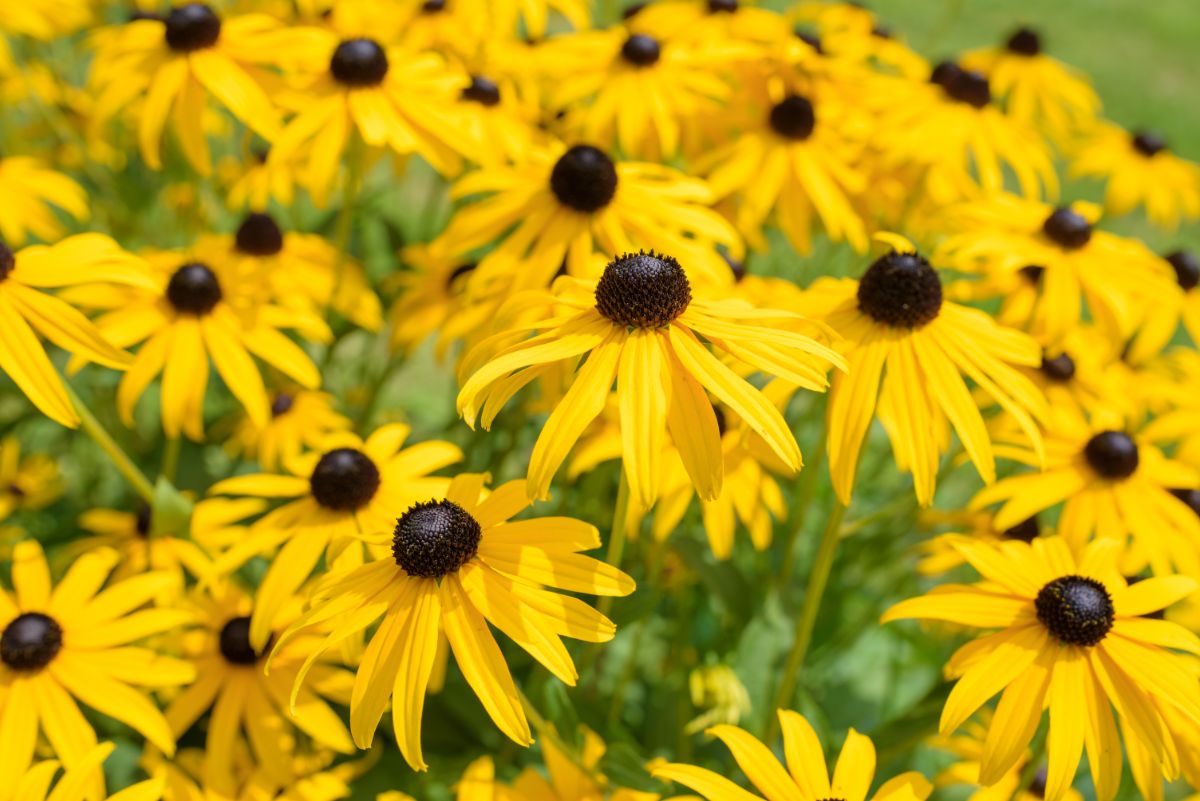
| Plant name: | Black-eyed Susan |
| Light requirements: | Full sun |
| Water requirements: | Moderate |
| Growing zone: | Zones 3 to 10 |
| Special features: | Late season blooms; Great for cut flowers |
Black-eyed Susan is always popular in spring and summer gardens. Their cheerful blooms are daisy-like, with golden petals encircling a deep, chocolatey center. Perfect for homemade bouquets, black-eyed Susan is bewitching in garden designs, adding color, movement, and texture to any planting arrangement.
A relatively drought-tolerant plant, black-eyed Susan doesn’t need a lot of extra care once it becomes established in your garden. In fact, these plants readily self-sow, so if you don’t want a lot of them, be sure to deadhead spent flowers before they go to seed. Alternatively, if you choose to leave old blooms in place at the end of the season, wild birds will visit your garden to gobble up the seeds!
4. Sweet alyssum (Lobularia maritima)

| Plant name: | Sweet alyssum |
| Light requirements: | Full sun to part shade |
| Water requirements: | Moderate |
| Growing zone: | Zones 5 to 9 |
| Special features: | Groundcover; Pollinator favorite |
Often used as an accent plant in container gardens, sweet alyssum is a low-growing plant that makes an exceptional filler plant and groundcover in inground plantings too. Petite flowers come in white, pink, and purple and are highly attractive to bees and other pollinators. Alyssum’s dense growth also makes this plant great at blocking weeds!
Sweet alyssum needs well-draining soil, so it will appreciate sandier gardens as long as you keep your beds well-watered. Adaptable to both sun and part shade, sweet alyssum will liven up your garden with flowers from spring until fall. Just keep in mind that sweet alyssum blooms less during the heat of summer, although flowers will revive when temperatures fall in autumn.
5. Bearded iris (Iris × germanica)
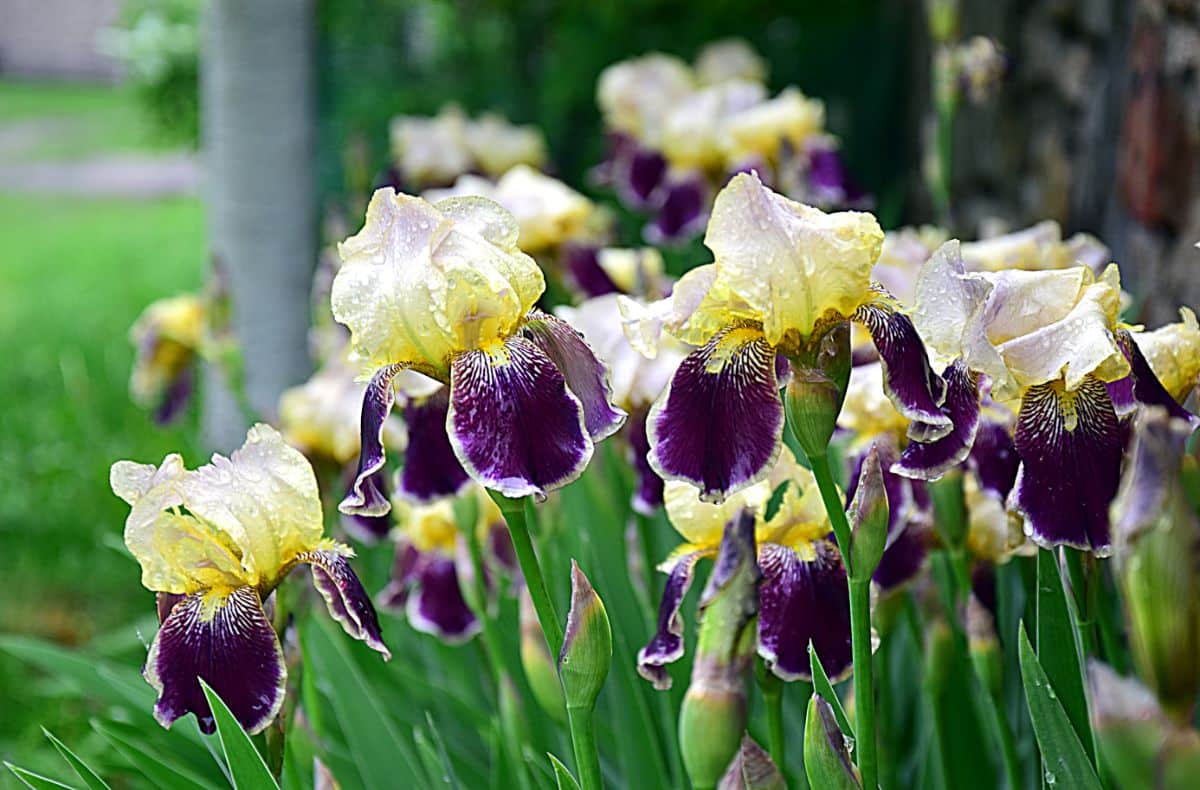
| Plant name: | Bearded iris |
| Light requirements: | Full sun |
| Water requirements: | Moderate |
| Growing zone: | Zones 3 to 9 |
| Special features: | Divides easily |
Bearded irises come in many different sizes, including dwarf species and taller specimens that reach between 28 and 38” tall. You can find iris blooms in just about any color you could want too, which makes irises a wonderful pick for any garden space. Many iris varieties bloom in spring and again in autumn for season-long color.
Irises are usually grown from bulbs that are planted from September to December. After a fall planting, irises will usually bloom the next year, and they will naturally spread and divide over time. To keep your plants from getting overcrowded, divide irises every 3 to 5 years or when they begin to produce fewer flowers.
6. Butterfly bush (Buddleja spp.)
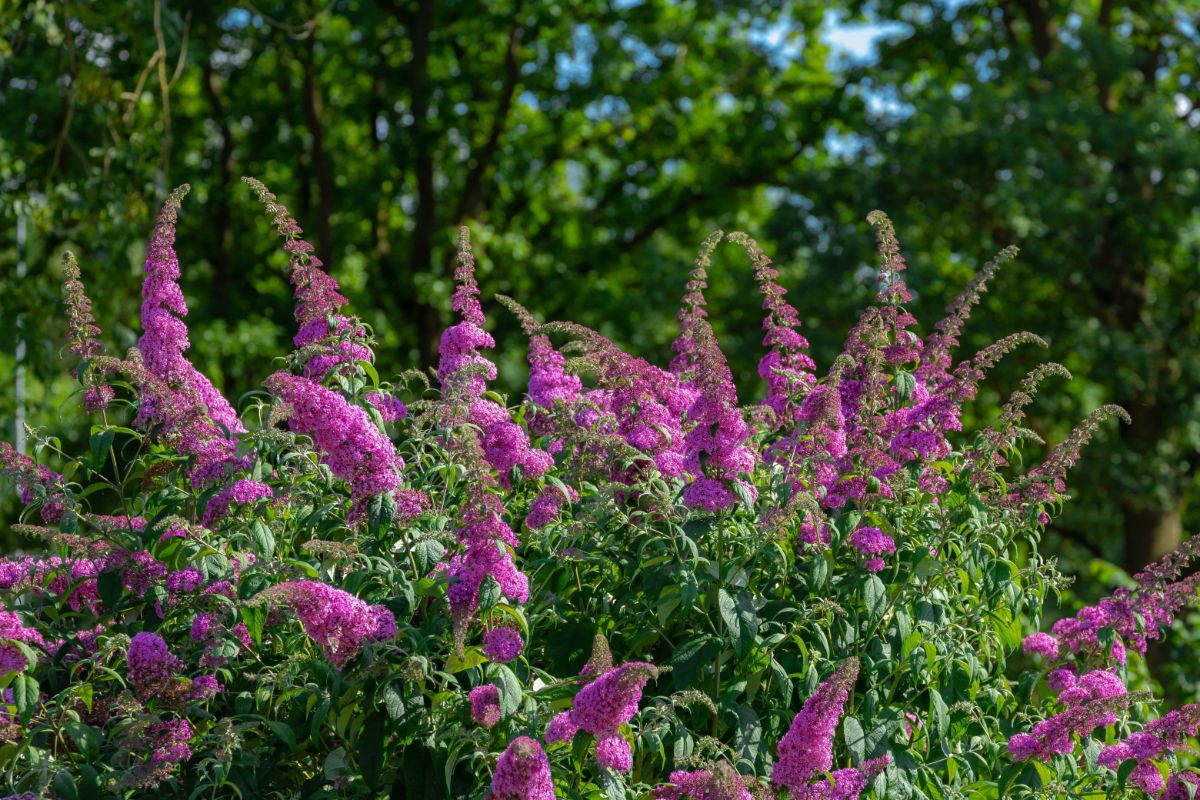
| Plant name: | Butterfly bush |
| Light requirements: | Full sun |
| Water requirements: | Moderate |
| Growing zone: | Zones 5 to 9 |
| Special features: | Pollinator favorite; Privacy shrub |
If you want to keep a pollinator garden, one of the best plants to include is the butterfly bush. This attractive plant looks a bit like a lilac with conical bunches of flowers in white, purple, and pink. Butterflies and hummingbirds can’t resist this highly fragrant plant, and growing a butterfly bush or two is sure to have your garden thrumming with wildlife in no time.
Butterfly bushes grow to about 15’ tall, but you can keep them smaller with frequent trimming. The best time to prune a butterfly bush is in the spring after new growth has started to sprout. Pruning plants too late in the season can make them more susceptible to winter damage and reduce the next season’s blooms.
7. Foxglove (Digitalis spp.)
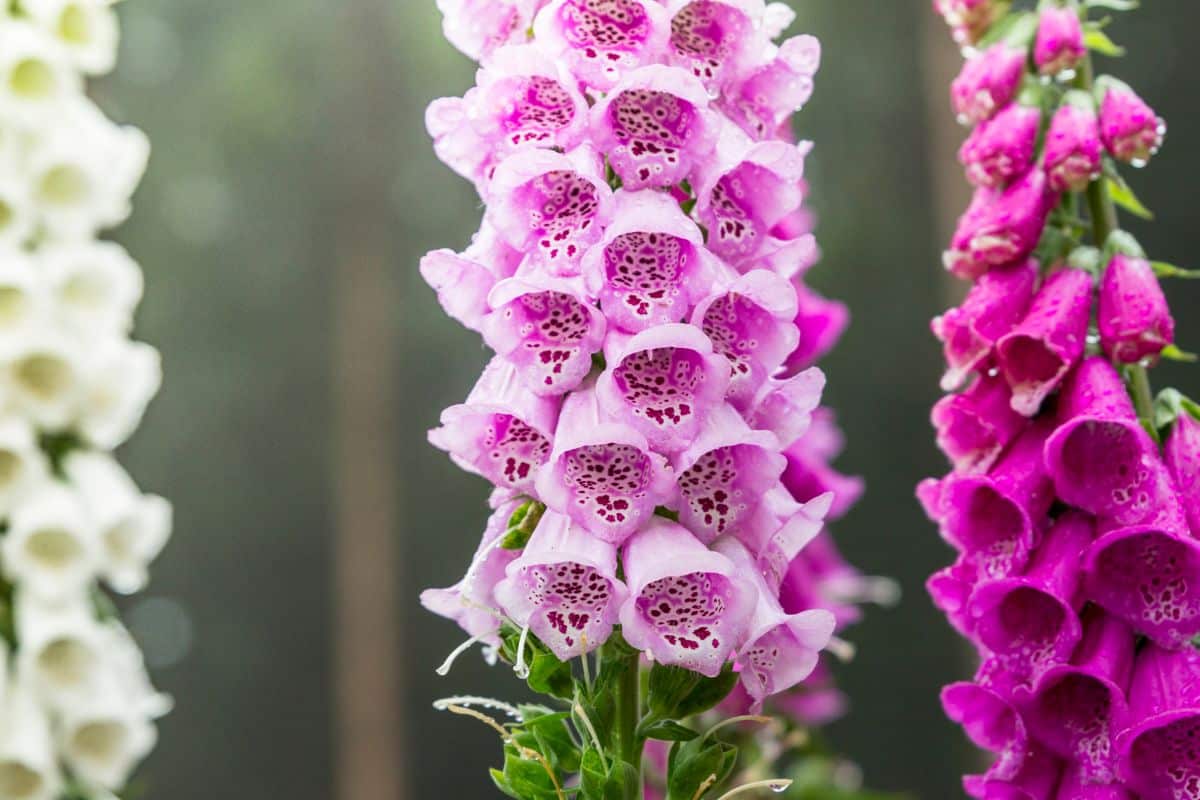
| Plant name: | Foxglove |
| Light requirements: | Full sun to part shade |
| Water requirements: | Moderate |
| Growing zone: | Zones 4 to 9 |
| Special features: | Pollinator favorite; Unique look |
Foxglove has a whimsical look with tall spires of bell-shaped flowers that come in a range of colors. Most commonly, you’ll find foxgloves in pinks and purples, but yellow, orange, red, and other colors are available as well. Thanks to their unique look, foxgloves are a top choice in fairy gardens, but they can also thrive in shady spots and sandy soil too.
Foxgloves are biennial plants that produce leaves during their first year of growth. In their second year, foxgloves flower and then release a profusion of seeds that readily self-sow. Foxgloves are often included in wildflower mixes and can be grown from store-bought seeds or nursery starts as well.
8. Daylily (Hemerocallis lilioasphodelus)
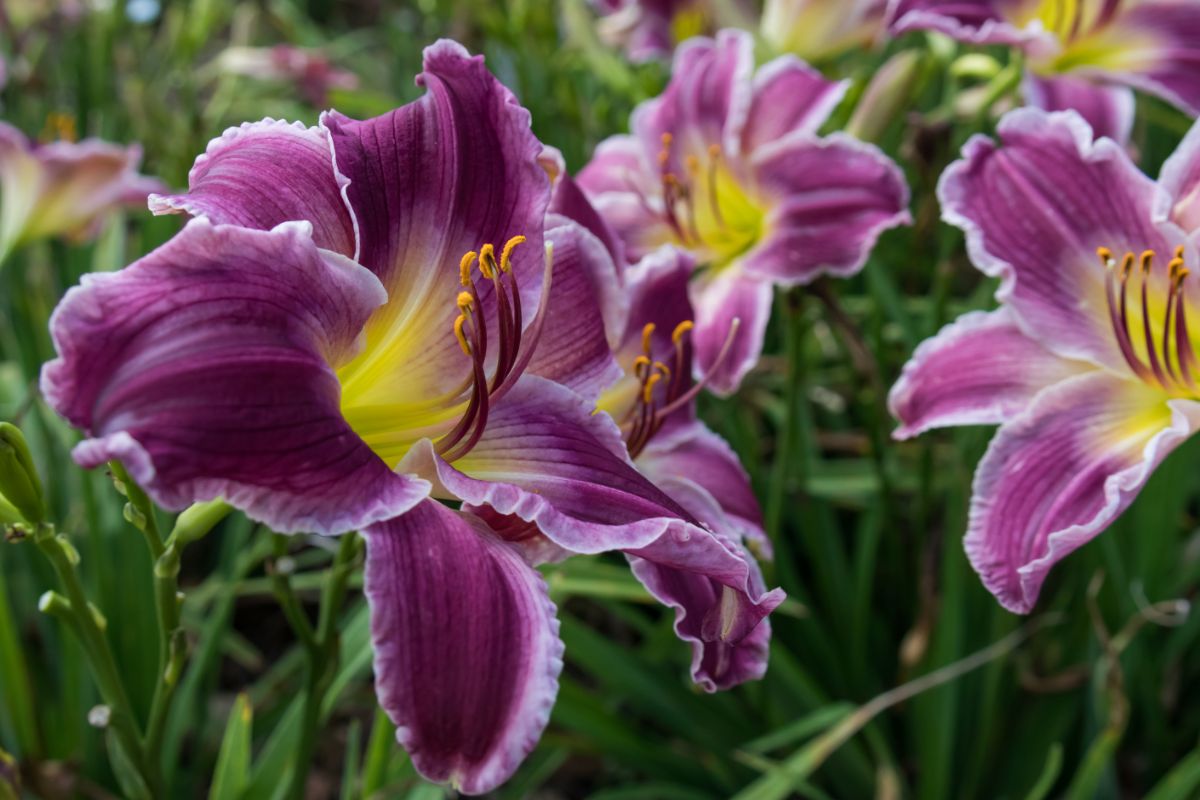
| Plant name: | Daylily |
| Light requirements: | Full sun to part shade |
| Water requirements: | Moderate |
| Growing zone: | Zones 2 to 11 |
| Special features: | Edible; Divides easily |
Despite their name, daylilies aren’t true lilies, but that doesn’t detract from their charm. Native to Asia, daylilies have become naturalized throughout Europe and the Americas, and they grow abundantly in both full sun and partial shade. Preferring well-draining soil, daylilies can grow in different soil types, including sandy and clay-rich earth.
Most often, you’ll find daylilies with orange blooms, but they come in other colors too. Intriguingly, all parts of the daylily plant are edible. Tubers can be cooked like potatoes, petals make colorful salad toppers, and buds can be pickled, fried, or mixed into veggie lo mein!
9. Giant allium (Allium giganteum)
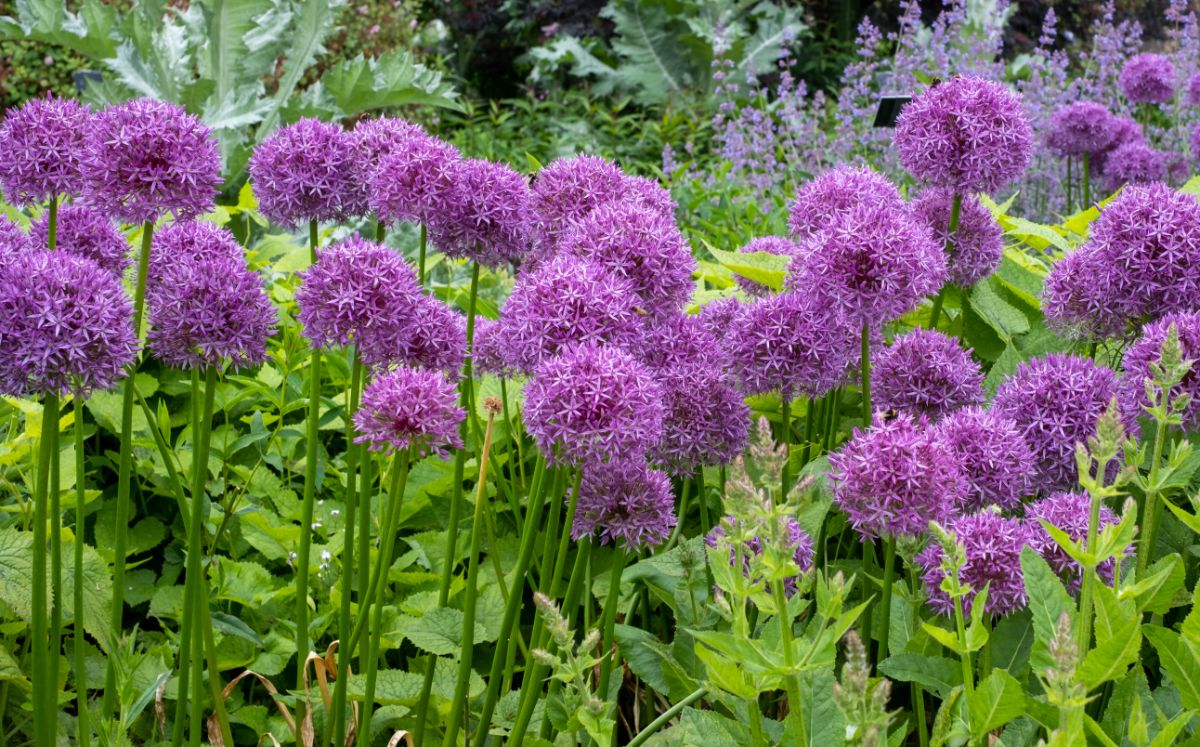
| Plant name: | Giant allium |
| Light requirements: | Full sun to part shade |
| Water requirements: | Low |
| Growing zone: | Zones 3 to 9 |
| Special features: | Pest resistant; Drought resistant |
Alliums, including the giant allium, can grow in sandy gardens as long as you provide them with enough water and a bit of extra fertilizer. A relative of onions and chives, these easy-going plants are generally grown from bulbs, although you can purchase them as nursery starts for earlier blooms. Bulbs are usually planted in autumn, and flowers emerge the following year in late spring to early summer.
One of the perks of growing alliums is that they are naturally resistant to many garden pests. Voles and other burrowing rodents love eating bulbs, but they tend to shy away from alliums. Even better, alliums’ strong scent repels many garden pests, which makes these plants valuable companions for natural pest control.
10. Russian sage (Perovskia atriplicifolia)
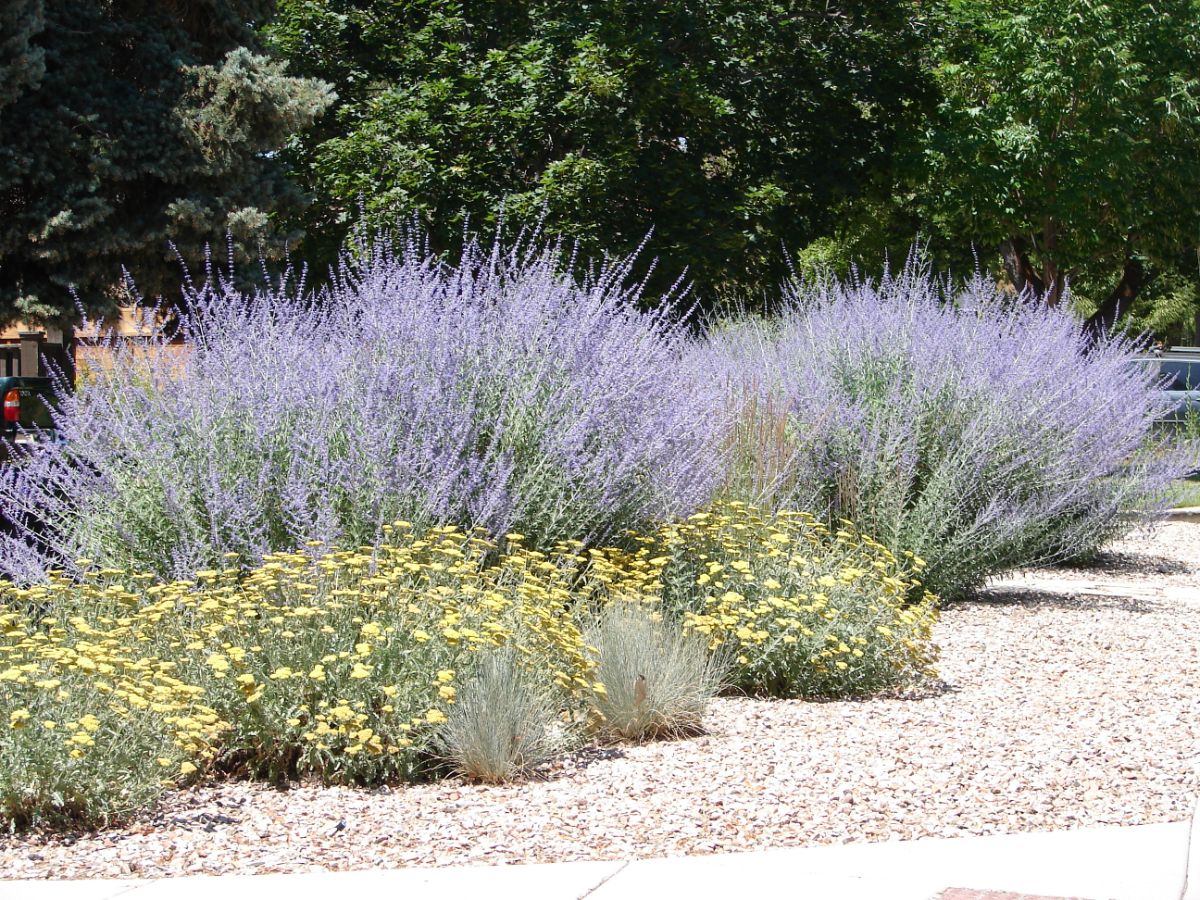
| Plant name: | Russian sage |
| Light requirements: | Full sun |
| Water requirements: | Moderate to low |
| Growing zone: | Zones 4 to 9 |
| Special features: | Pest resistant; Drought resistant; Highly fragranced |
Russian sage has a dream-like quality to it, with delicate, purple blossoms perched above the plant’s silvery-green foliage. When backlit by the sun, this plant is a true showstopper, and pollinators love it too! Not to mention, Russian sage is well-known for its fine fragrance, which becomes stronger when leaves are crushed underfoot or brushed up against during an evening stroll in the garden.
Naturally resistant to deer, Russian sage is a hardy plant that doesn’t need a lot of water. Since sandy soil doesn’t hold moisture in well, Russian sage is a perfect choice for any dry and sandy garden. Just remember that these plants can spread quite vigorously, and they may need to be pruned occasionally and divided every 4 to 6 years.
11. Phlox (Phlox paniculata)
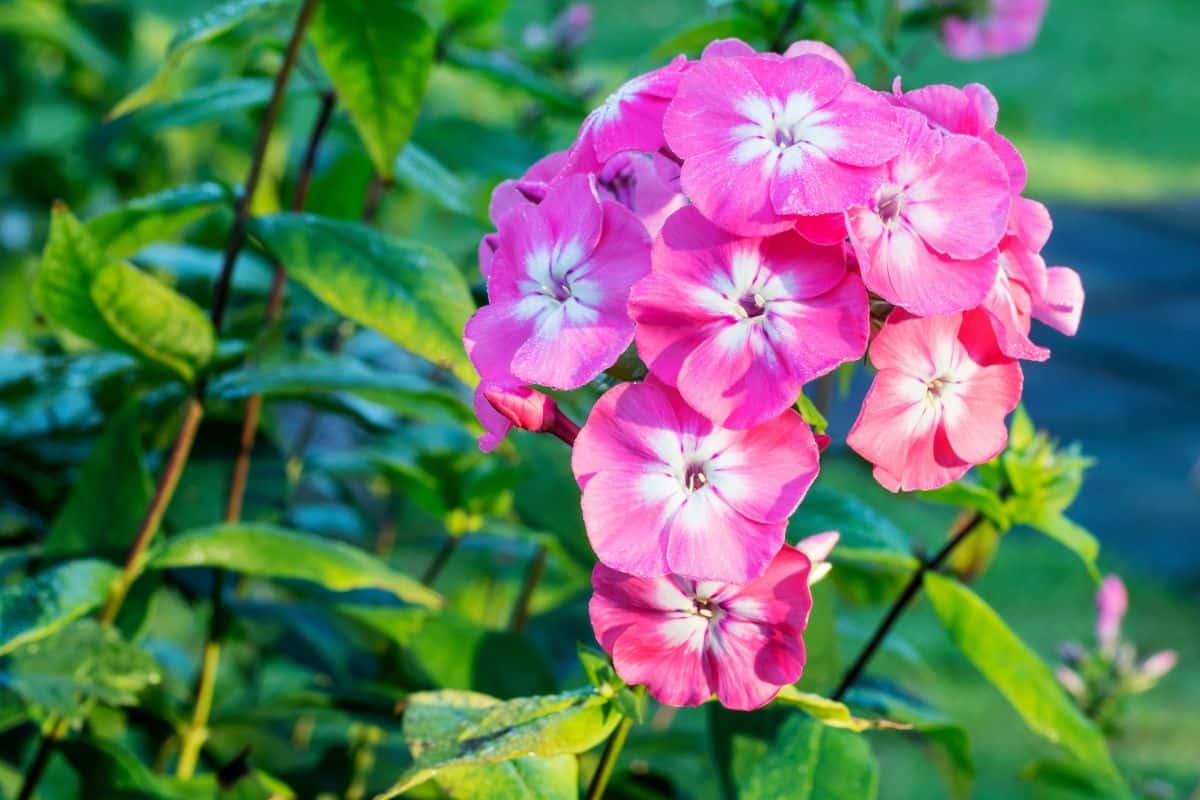
| Plant name: | Phlox |
| Light requirements: | Full sun to part shade |
| Water requirements: | Moderate |
| Growing zone: | Zones 4 to 8 |
| Special features: | Pollinator favorite; Highly fragranced |
Tall phlox blooms from mid-summer to fall and can lighten up your garden space with vivid flowers in white, pink, and other colors. Unlike creeping phlox, which is a spring-time bloomer, tall phlox grows between 2 and 3’ tall and looks particularly pretty when planted in groups of 3 or more. When in bloom, phlox exudes a delightful fragrance that is sure to lure butterflies and other beneficial insects to your garden.
Like other perennials, phlox should be divided every 2 to 4 years to keep plants from getting overgrown and to rejuvenate blooms. When sowing this plant, remember to follow proper spacing guidelines, as overcrowded plants can be prone to powdery mildew. It’s also important to keep phlox leaves as dry as possible to reduce fungal issues, so always water this plant at the base.
12. Joe Pye weed (Eutrochium purpureum)
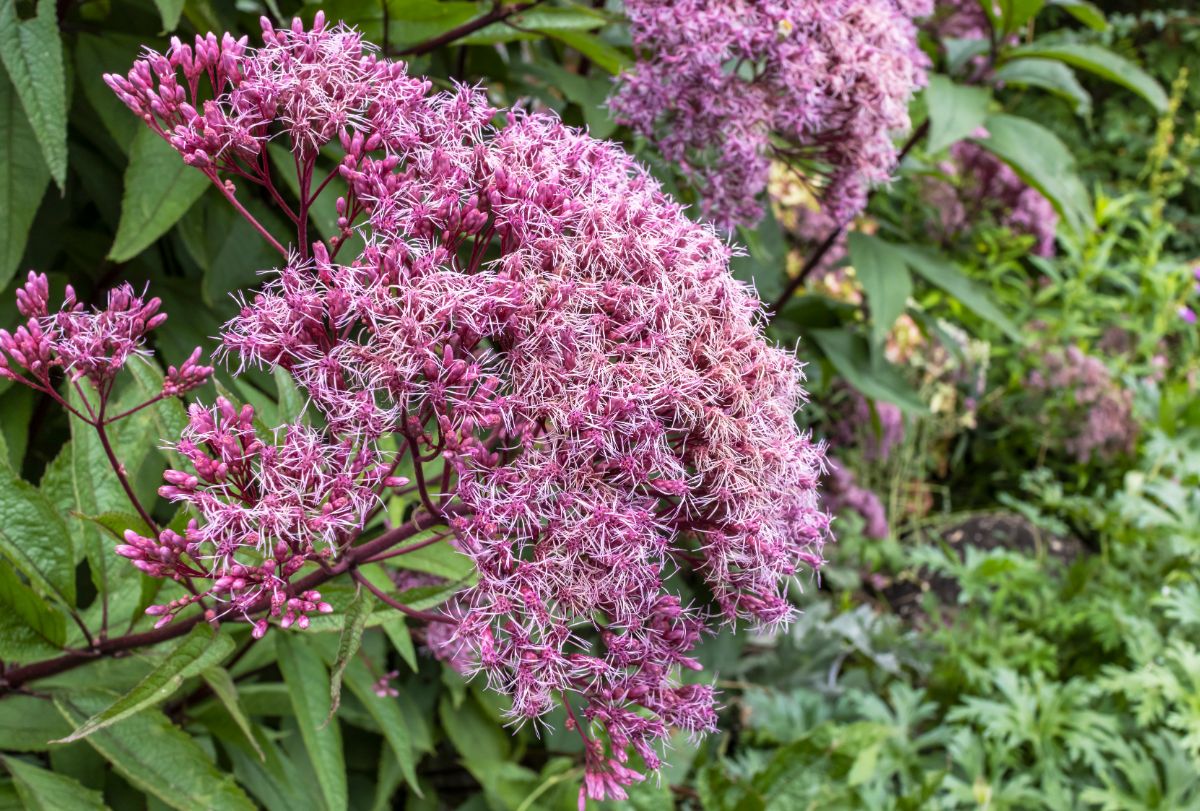
| Plant name: | Joe Pye weed |
| Light requirements: | Full sun to part shade |
| Water requirements: | High |
| Growing zone: | Zones 4 to 8 |
| Special features: | Pollinator favorite; Great for rain gardens |
Native to North America, Joe Pye weed naturally grows along streambanks and other moist areas. Although it can adapt to sandy soils, this moisture lover will need frequent watering to keep it from drying out. To preserve soil moisture levels even more, consider adding a thick layer of mulch around the base of your plant to slow down evaporation rates.
Since Joe Pye weed grows up to 8’ tall, you may want to locate this plant in an area by itself or sow it in the back of your garden beds to keep it from blocking out the light from lower-growing plants. When in bloom, Joe Pye weed’s large, broad, and fragrant flowers are irresistible to bees and other pollinators. Try planting Joe Pye weed with liatris or black-eyed Susan to create a garden bed with lots of texture and complementary colors.
13. Salvia (Salvia spp.)
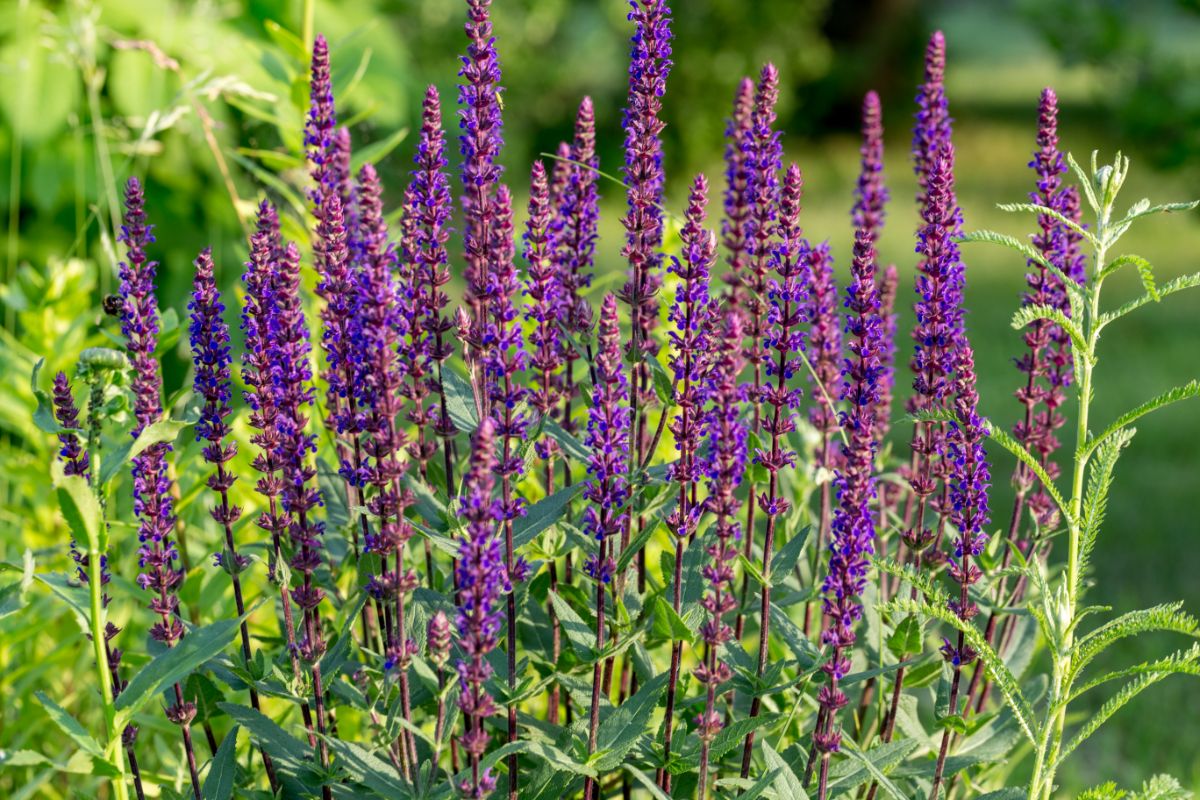
| Plant name: | Salvia |
| Light requirements: | Full sun to part shade, depending on the variety |
| Water requirements: | Moderate to low |
| Growing zone: | Zones 4 to 10, depending on the variety |
| Special features: | Pollinator favorite |
With between 700 and 3000 different species of salvia, there is a lot of variety to choose from in this plant family. Some varieties of salvia are annuals, while others are perennials. Flower color is quite varied, too, although purple and red blooms tend to be the most common.
What unites most species of salvia is the fact that these plants are easy to maintain and adaptable. Many varieties of salvia prefer drier conditions and can handle sandy soils with ease. These plants are also highly attractive to bees and are a perfect addition to pollinator gardens.
14. Butterfly weed (Asclepias tuberosa)
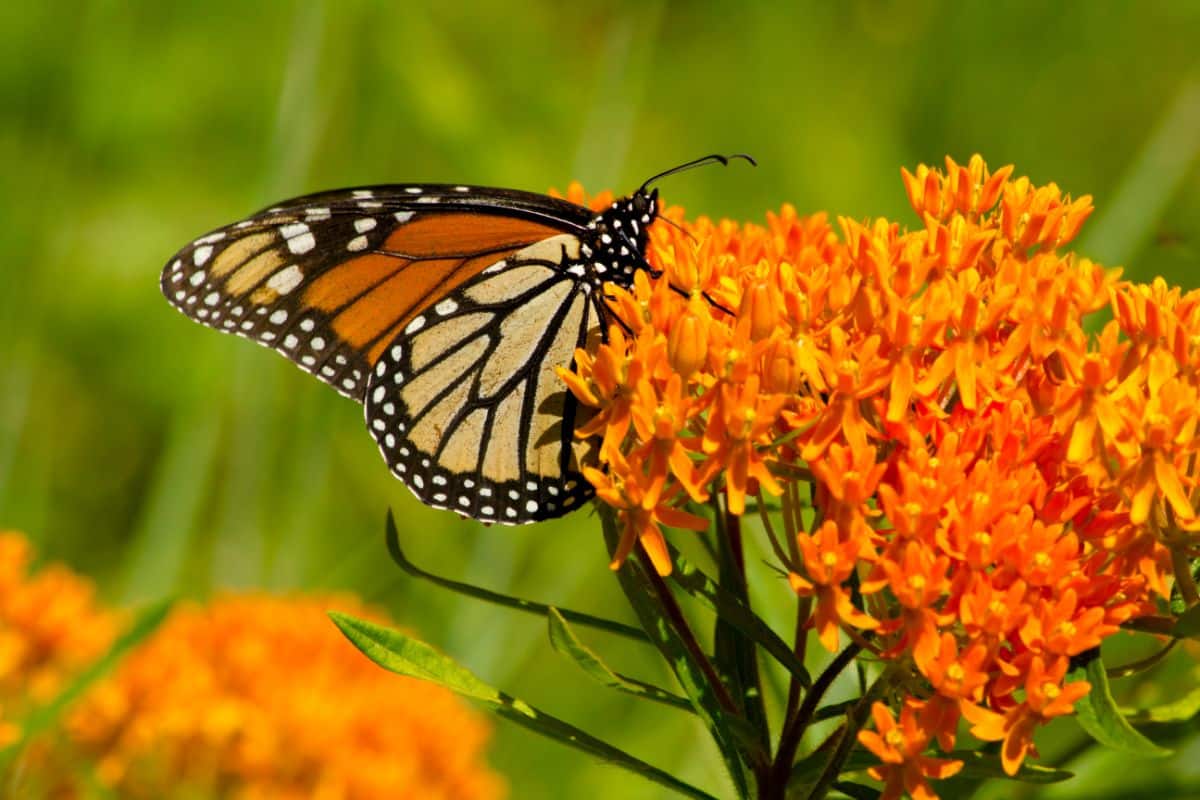
| Plant name: | Butterfly weed |
| Light requirements: | Full sun |
| Water requirements: | Low |
| Growing zone: | Zones 3 to 9 |
| Special features: | Pollinator favorite; Drought resistant |
A variety of milkweed, butterfly weed is well-known for its intensely colored orange blooms that are sure to draw the eye. Like other milkweed species, butterfly weed is a critical plant for pollinators, and it serves as a host plant for monarch caterpillars. For this reason, if you want to keep butterfly weed in your garden, opt for organic pest control measures whenever possible to support pollinator health.
Butterfly weed can be grown from nursery starts or seeds. Seeds tend to be the more economical way to grow this plant; however, it can take up to 3 years for plants to bloom when grown from seed. Like other wildflowers, cold stratifying butterfly weed seeds before planting will speed up germination rates and also boost seedling success.
15. Liatris (Liatris pycnostachya)
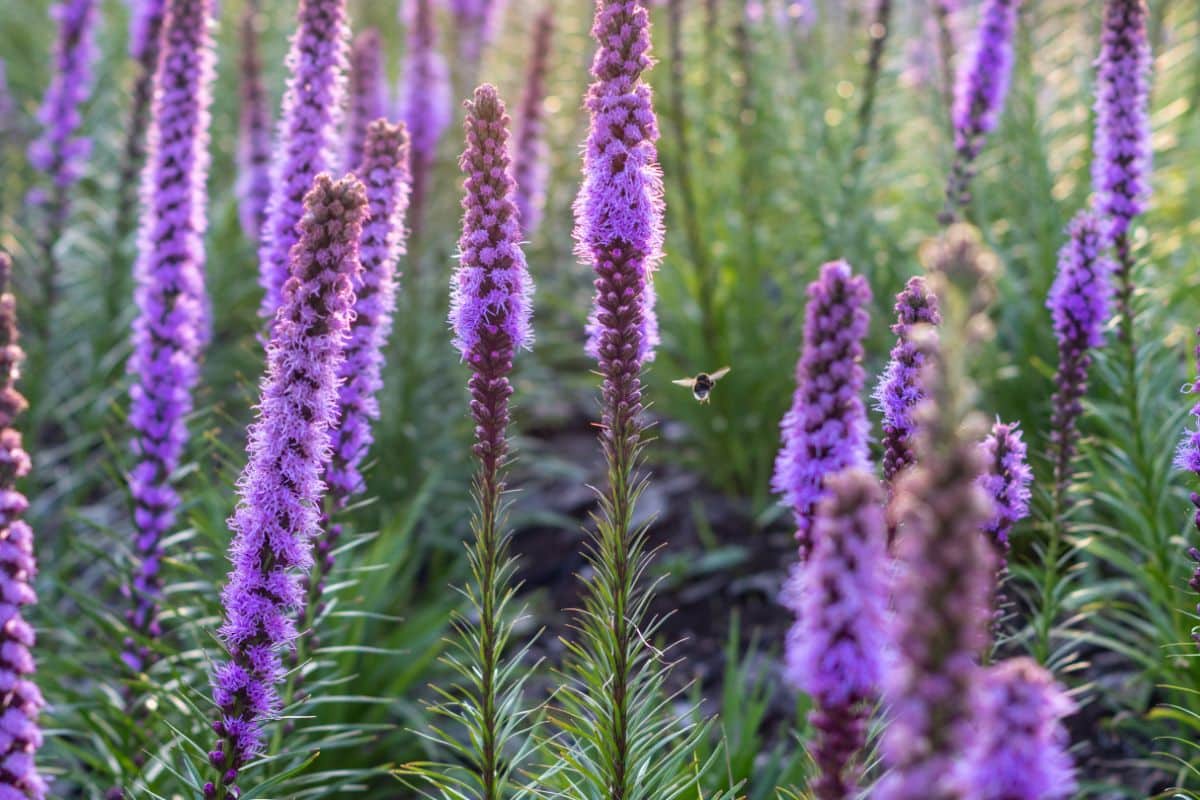
| Plant name: | Liatris |
| Light requirements: | Full sun |
| Water requirements: | Low |
| Growing zone: | Zones 3 to 8 |
| Special features: | Pollinator favorite; Drought resistant |
Also known as gayfeather and blazing star, liatris are structural plants with finely made columnar flowers in pink, purple, and white. A top food source for butterflies, liatris are low-maintenance plants that generally need little fuss and minimal water once they are established in your garden. In addition to their unique flowers, liatris features grass-like leaves, which can add movement and texture to your garden beds.
Liatris is usually grown from corms that are planted in spring. Flowers will bloom the first year, about 70 to 90 days after planting. Liatris contrasts nicely against the colors of black-eyed Susan, and it creates a fun display when paired with alliums.
16. Cleome (Cleome spp.)

| Plant name: | Cleome |
| Light requirements: | Full sun |
| Water requirements: | Moderate to low |
| Growing zone: | Zone 10 to 11, grown as an annual in cooler locations |
| Special features: | Pollinator favorite |
Also known as spider flowers, cleome have an unusual look with airy blooms punctuated by spiky stamens that are said to resemble a spider’s legs. Flowers come in white, pink, and purple and are very pretty when planted in large groupings. These plants are also popular among pollinators, although they don’t produce much of a fragrance.
Cleomes are annuals, and they are usually grown from seed, although you may be able to locate nursery starts. Seeds can be planted directly in the garden in spring after all danger of frost has passed. Some species may grow better if cold stratified before planting, but most cleome will bloom about 70 to 80 days after sowing.
17. Columbine (Aquilegia spp.)
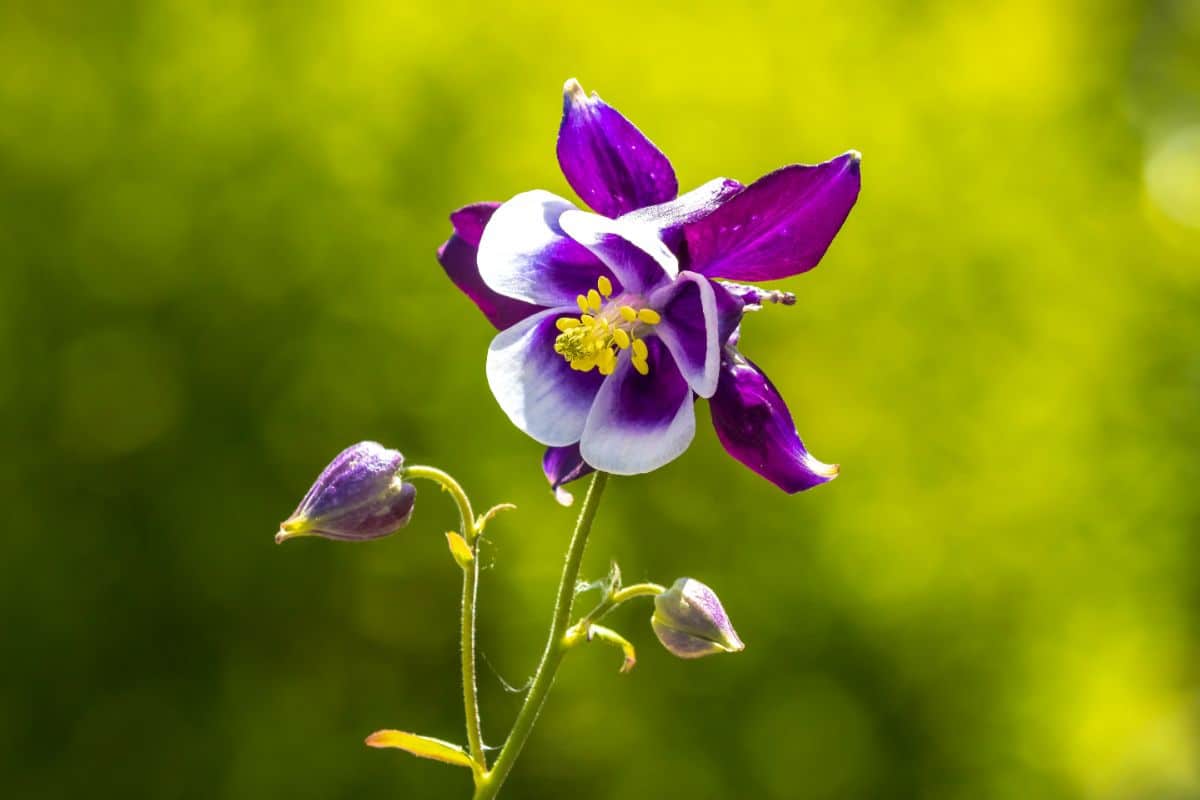
| Plant name: | Columbine |
| Light requirements: | Full sun to part shade |
| Water requirements: | Moderate |
| Growing zone: | Zones 3 to 9 |
| Special features: | Pollinator favorite |
Columbine have very distinct flowers with angular spurs that are said to resemble an eagle’s talons. This helps explain the plant’s Latin name, “Aquilegia,” which means eagle!
Native to woodlands and meadows throughout North America, columbines are easy-going plants that can adapt to sandy soil as long as they get enough water. As short-lived perennials, columbines won’t last in your garden quite as long as some of the other species on this list, but they do self-seed easily. If you want to keep your columbine patch going for years, don’t deadhead spent flowers and allow the plants to sow themselves.
18. Hosta (Hosta spp.)
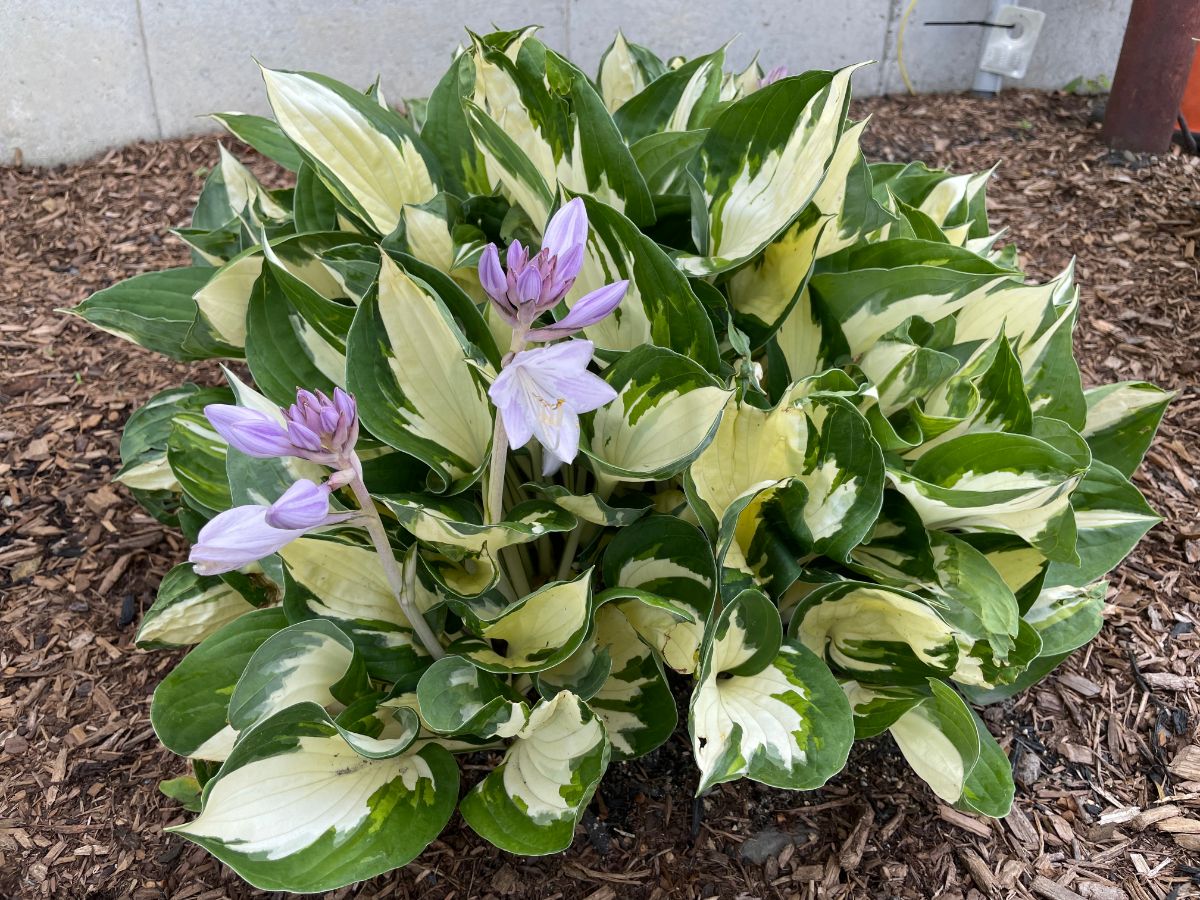
| Plant name: | Hosta |
| Light requirements: | Shade |
| Water requirements: | Moderate |
| Growing zone: | Zones 3 to 9 |
| Special features: | Great for shade gardens; Edible |
Hostas are hardy plants that grow in a range of adverse conditions, including gardens that are rich in sand or clay. Often used as accent plants, hostas are well-known for their highly variegated leaves, although you can find species with solid green foliage. Hostas also bloom charming spires of tubular flowers in white or pastel hues.
Because hostas don’t like a lot of sun and they can be prone to sunburn, any hostas you grow should be kept in part shade to full shade areas. These plants can also be susceptible to slug damage, so consider keeping “slug pubs” nearby. Also known as plantain lilies, hostas are edible and have a flavor that is reminiscent of asparagus!
19. Larkspur (Delphinium spp.)
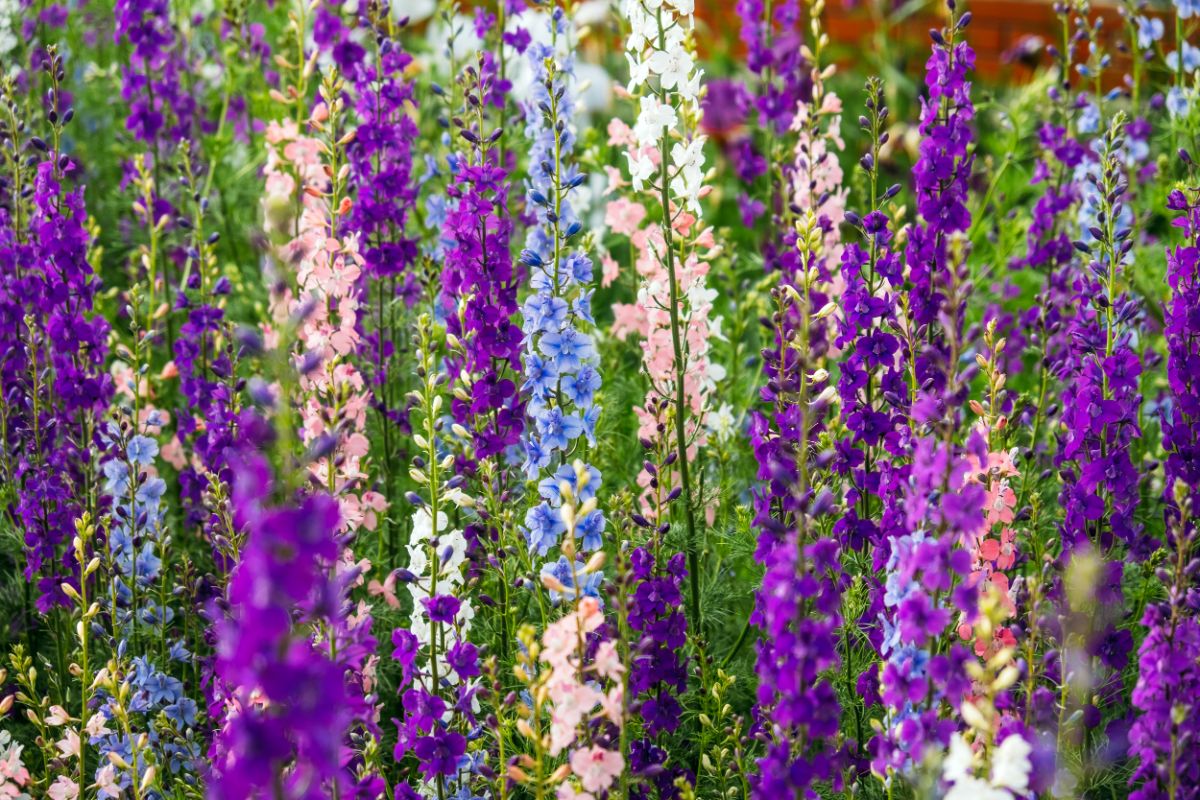
| Plant name: | Larkspur |
| Light requirements: | Full sun |
| Water requirements: | High to moderate |
| Growing zone: | Zones 2 to 11 |
| Special features: | Pollinator favorite; Good for pressed flowers |
Larkspurs are a variety of delphinium that grow annually. Flowers bloom on tall stalks and are composed of delicate petals that range in color from pink to purple and white. Larkspur has a long bloom time, and you will usually get flowers up until the first hard frost of autumn.
Larkspur can be purchased as nursery starts, but it is more common to grow this plant from seeds. Seeds can be directly sown in the garden in either fall or spring. Since it requires a period of cold in order to germinate, spring-planted larkspur seeds should be cold-stratified before sowing.
20. Cosmos (Cosmos spp.)
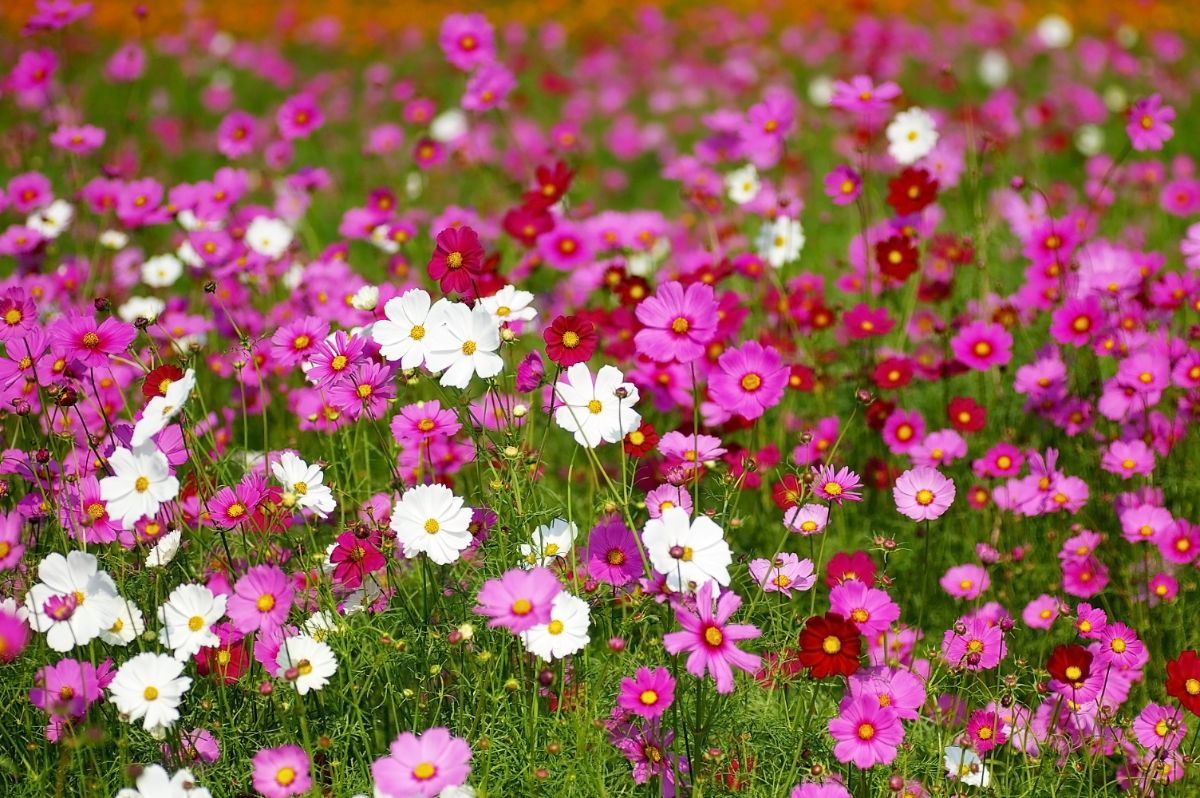
| Plant name: | Cosmos |
| Light requirements: | Full sun |
| Water requirements: | Moderate to low |
| Growing zone: | Zones 2 to 11 |
| Special features: | Good for bouquet making |
Cosmos are jolly little plants with feathery foliage and wide-open blooms in pink and white. Most often, cosmos grow as annuals, and they are easy to start from seeds. Once established in your garden, cosmos will easily self-sow, and you often won’t have to replant them!
In addition to being attractive plants, cosmos are a hit with pollinators, and they’re perfect for bouquet making too. These adaptable plants can thrive in sandy soil, but they produce more blooms in full sun.
21. Yarrow (Achillea millefolium)

| Plant name: | Yarrow |
| Light requirements: | Full sun to part shade |
| Water requirements: | Low |
| Growing zone: | Zones 3 to 9 |
| Special features: | Pollinator favorite; Drought resistant; Excellent dried flowers |
Yarrow is a resilient plant that can handle drought and poor soil, so you know they will adapt to sandy gardens too! A top pollinator plant, yarrow’s broad, flat blooms provide the perfect landing pad for butterflies to perch on when feeding. Bees love yarrow as well!
Yarrow has fine and feathery foliage, which makes a lovely complement to the plant’s stately blooms. Yarrow flowers come in white, yellow, pink, red, and orange. These flowers also preserve beautifully in dried bouquets, and they make superb fresh arrangements too!
Summary
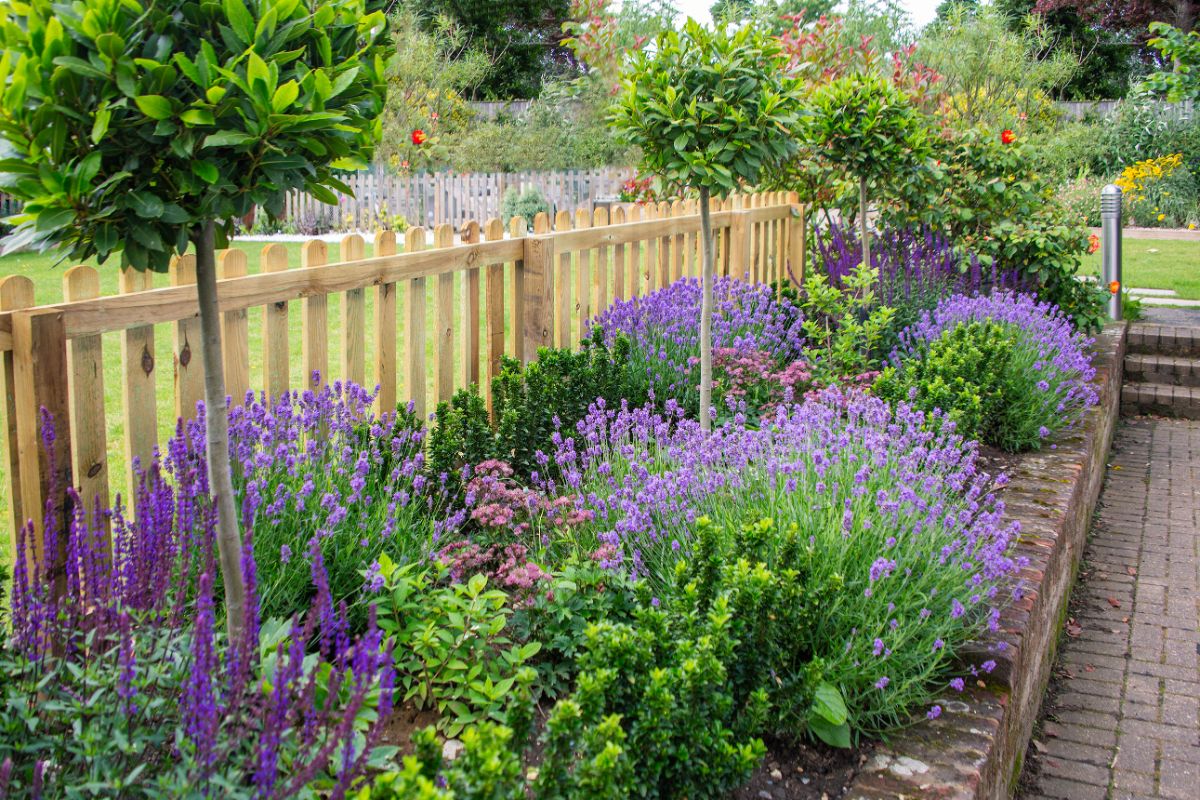
Keeping plants happy in sandy soil can be tricky, but it’s not impossible. Before you plant anything, consider amending your soil with compost or other organic matter to boost your soil’s ability to retain water and nutrients. After that, choose the right plants for sandy gardens, and you’re well on your way to growing a successful flower bed!
Selecting plants with low water needs can cut down on your gardening tasks and help you adapt to sandy soils. If you are still struggling with dry beds, you may also want to consider adding a drip irrigation system, which will keep your plants well-watered without you needing to do anything. These systems can be automated to conserve water and provide irrigation even when you’re on vacation.
If you’d like to learn more tips for keeping a sandy garden well irrigated, check out our guide on watering here or read up on how to make your own compost in this easy tutorial.

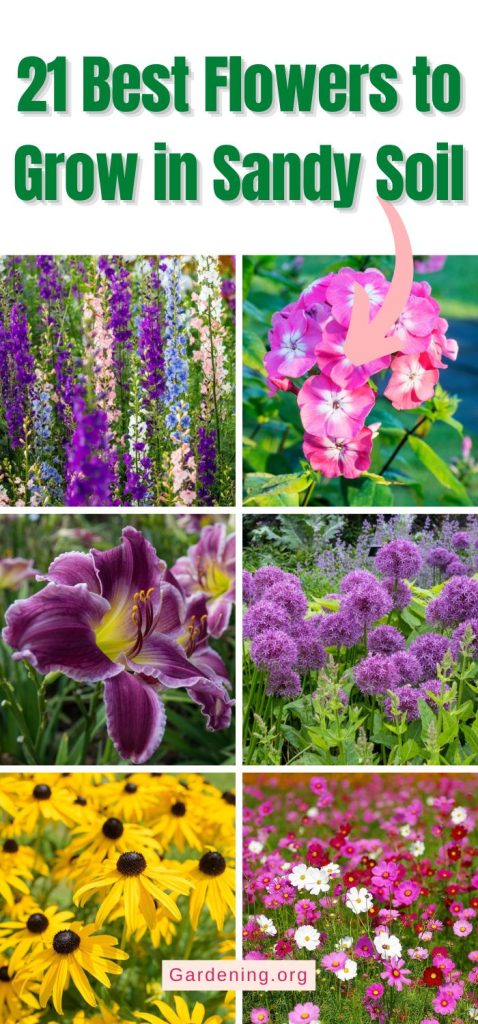

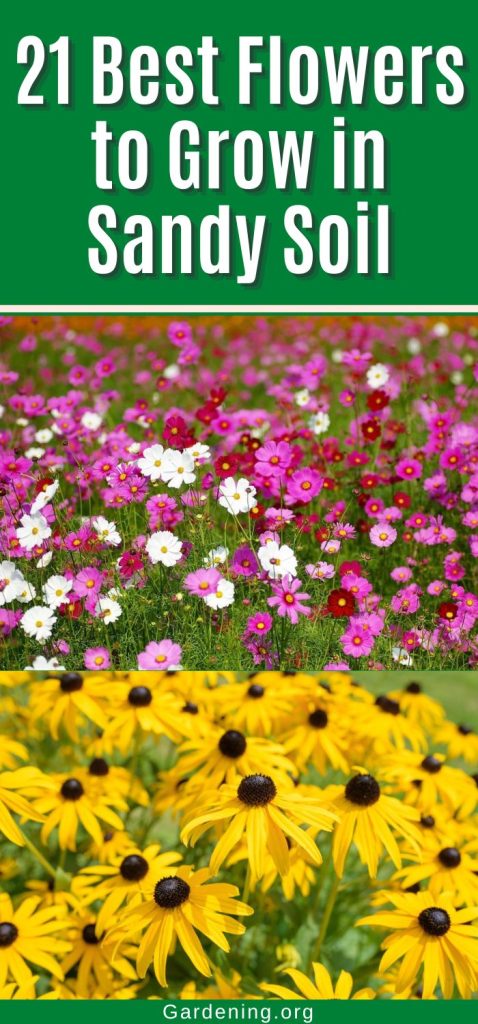
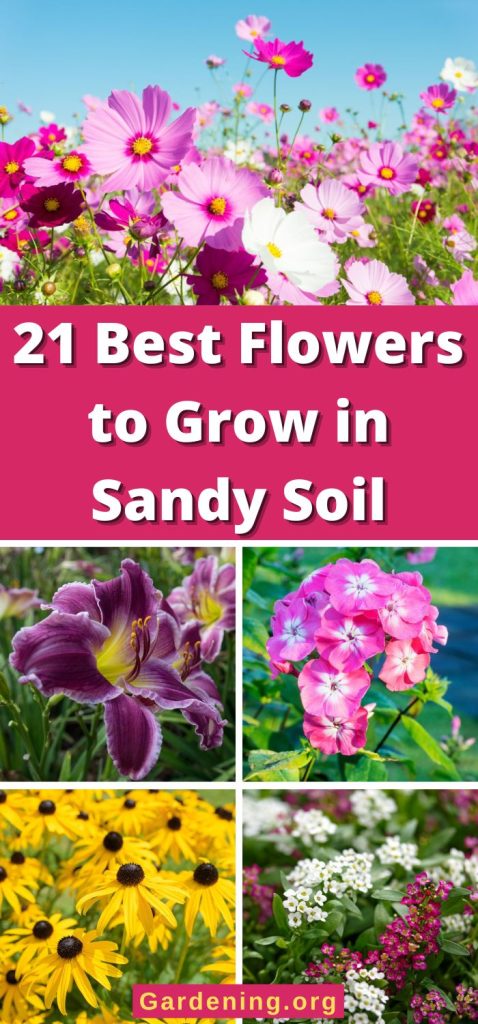

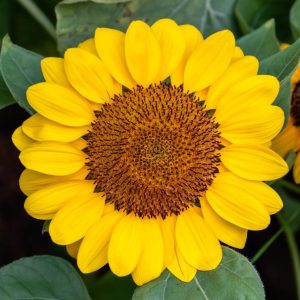
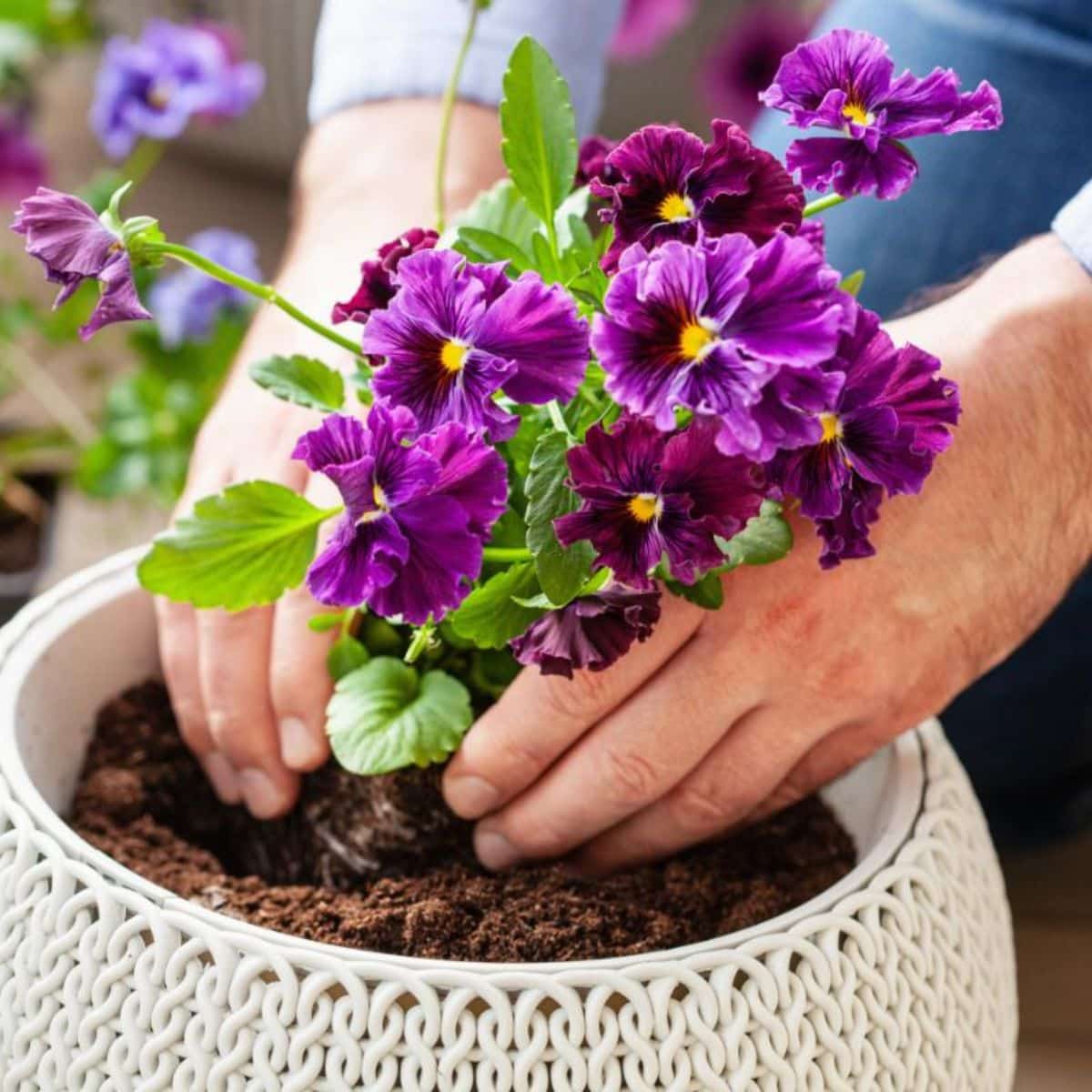
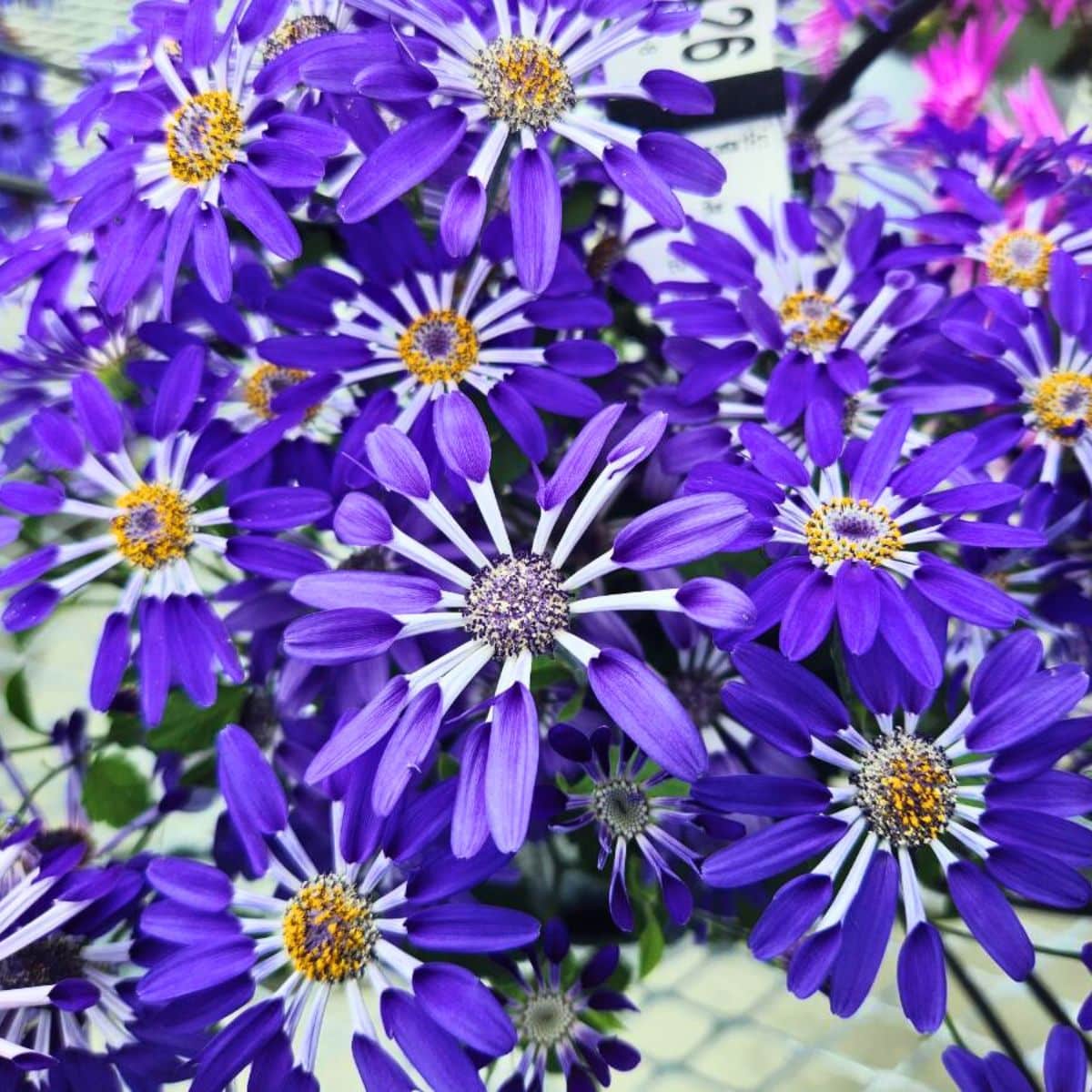
Leave a Reply